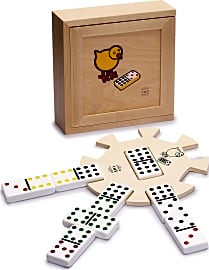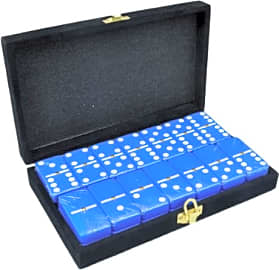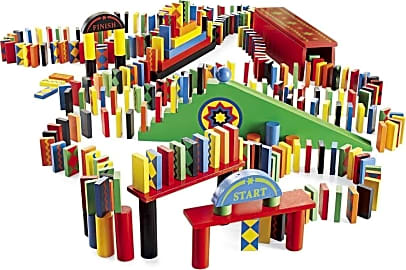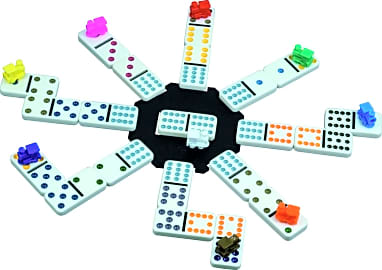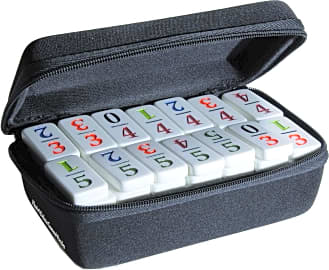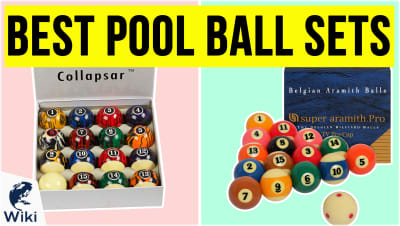The 10 Best Dominoes Sets

This wiki has been updated 39 times since it was first published in September of 2015. First believed to have been sold during the reign of Emperor Xiaozong in 12th century China, dominoes have evolved into many games beloved around the world. Something from our comprehensive selection is sure to entertain you and your family for years, as we've included traditional sets for playing as well as some designed specifically for creating decorative runs that you tip over. When users buy our independently chosen editorial choices, we may earn commissions to help fund the Wiki.
Editor's Notes
October 29, 2020:
We wanted to preserve the diversity of our selections while also making sure it was up to snuff for this latest round of updates. Most of these will allow you to play the three basic types of domino games, with the exception of options that are meant specifically for stacking and runs. There is also something to cater to every age group, from the very young to the elderly.
We said goodbye to the Regal Games Double 9, which became unavailable, and replaced it with the Pressman Family Classics, a similar choice with more tiles, a Mexican train starter piece, and comprehensive rules. And while we love having choices like the HearthSong Rally and Lewo 1,000-Piece on hand that are geared toward kids, they happen to be fun for adults as well. That coupled with the fact that many sets on here, such as the newly-added Yellow Mountain Imports Chicken Foot and Refinery And Co. Backyard, are just as entertaining for children, meant we felt we could remove the InTemenos Kids to pave the way for more versatile options.
The sets you'll find here are solid and durable, but be aware that in this category, the lower the price the higher the chance you'll run into quality control issues with thickness, pip sizing, paint, and casing. Thankfully, replacing a damaged or missing tile is an inexpensive affair.
When you think of the classic set that most households have hidden away in the closet, the Marion Double Six, CHH Jumbo, and Yellow Mountain Imports 28 likely come to mind. Pair one of these with a backgammon or chess set, and you'll have a trifecta of fun options for family game night.
December 03, 2019:
We have kept sets for playing games of dominoes as well as some for toppling, including those for all ages so the whole family can get in on the fun. When it comes to the former, the CHH Jumbo Double Six still comes out on top, since it is offered in several colors and has a sturdy case for travel. We have removed the Front Porch Classics Mexican Train, however, over concerns about its long-term wear. In its place, you'll find the Puremco ChickenFoot. It has big color-coded pieces that older kids should be able to use with ease. But if you prefer Mexican Train, the Deluxe Games and Puzzles Mexican Train remains a good alternative, especially for a family board game night.
For creating runs, we still like the HearthSong Rally thanks to its bright colors, and we have added the Lewo 1,000-Piece. We think it's a better value than the Click N' Play 300-piece; with 1,000 pieces, it is sure to keep adults and kids busy for hours. Note that the pieces in these sets do not have any pips, so they won't allow for an actual game of dominoes.
Special Honors
Alex Cramer #900 Le Club Looking for a personalized gift for a domino lover? The Alex Cramer #900 Le Club should fit the bill. There are engraving and imprinting options for thoughtful customization that is sure to be a big hit. Don't expect this set to come cheap, though. alexcramer.com
GammonVillage Double 6 Swarovski Crystal When you want to add a touch of luxury to your game night, the GammonVillage Double 6 Swarovski Crystal is just the option to consider. As you may have guessed, the pips are genuine Swarovski crystals, and each set is made by hand in Italy. gammonvillage.com
Brouk & Co. Onyx Featuring black and white ceramic dominoes, the Brouk & Co. Onyx is a set that is sure to turn heads. You can choose from among several case colors, each crafted from elegant vegan leather and lined with black felt to keep the pieces safe during transport. broukandco.com
Throw Them a Bone: Your New Domino Set
Such sets often have many more dominoes included, allowing you to play many variations beyond the basic blocking games played with 28 tiles.
The game of dominoes has been played for centuries, and its popularity transcends borders both cultural and geographical. Players old and young, casual and diehard alike enjoy round after round of the pastime; the clicking of the tiles fills the air of alleyways in Kingston to pubs in Britain and almost everywhere in between. We'll touch on the history and basic rules of dominoes later; for now, you have to consider which domino deck -- the common term for the set -- is the right one for you.
If you have rarely or never played dominoes before and you're not sure whether you will develop a passion for the game, a decent set of tiles -- also often called bones -- won't set you back any more than a cheeseburger with French fries would; which is an agreeable investment if you only plan on playing the game a few times out of the year.
On the other end of the spectrum you can find sets made of hand-carved stone with bright and colorful crystal pips, the general term for numeral spots on each tile. Such sets often have many more dominoes included, allowing you to play many variations beyond the basic blocking games played with 28 tiles.
Beyond the game of dominoes there is another way to play with all those tiles: the chain reaction. As with traditional domino play, the young and old alike can enjoy the mesmerizing cascade effect of one domino after another knocking into one another, forming a fluid falling motion that continues along as lengthy a row as you had the patience to set up.
Any domino set can be used to build a line of tiles standing up, but if you're selecting dominoes primarily to be lined up and knocked down, there's no reason to buy a traditional set of tiles (which will often have only 28 individual pieces included). Instead, look for playsets purpose-built for lining up, stacking, and knocking down, many of which come with hundreds of pieces. Not only are dominoes amusing when played within this manner, but the process can also help develop everything from fine motor control to spatial reasoning skills to the same type of critical thinking that plays a role in mathematics, engineering, and science.
How To Play Basic Dominoes
There are dozens of different ways to play a game of dominoes. Most variations fall into three categories, the blocking game, the scoring game, and the draw game.
As the most basic, most popular, and easiest-to-learn derivation of domino play is a blocking game, it is on this type of play that we will focus.
A standard blocking domino game uses a 28-tile set, usually known as a double-six deck. (The double-six tile, or the tile with each half sporting six pips for a total of twelve, being the set's largest tile in terms of number value.) Two, three, or four players can participate in the game.
Therefore a starting tile with one blank half and one half with three pips could be joined by a tile with either a black or three-pip section.
Prior to play, all of the tiles are laid flat with their faces down and are shuffled about until thoroughly mixed. These tiles are referred to either as the boneyard or the stock. When two or three players share a game, any tiles not drawn from the boneyard are put aside until a later match.
Each player then draws seven tiles, keeping their faces hidden from the other player(s). The designated starting player then lays one of their tiles down face up, thereby starting the line of play. Subsequent moves involve players laying down tiles that match the pip value of an exposed half of a tile. Therefore a starting tile with one blank half and one half with three pips could be joined by a tile with either a black or three-pip section.
Double tiles, such as tile with two halves both sporting two pips, can be laid down in perpendicular orientation to a tile half with a value matching each of its sections; a double-two tile could be placed next to the two pip side of a two-four file, e.g.
A player who cannot lay down a tile is skipped over. The game ends when one player is out of tiles or when neither player can continue laying down tiles. In this latter case, the last player to place a tile is considered the winner. He or she is awarded a number of points matching the pip count from all opponents' tiles.
A Brief History of Dominoes
People have been playing dominoes for at least eight hundred years. Writings dating to China's Yuan Dynasty, which spanned part of the 13th and most of the 14th centuries, make clear mention of game pieces that are undeniably similar to modern domino tiles. It is entirely possible, of course, that similar games were played for centuries if not even millennia before this written record.
From early 18th century Italy, dominoes quickly spread across much of the rest of Europe, gaining particular popularity in France.
The game of dominoes not only originated in China, but in fact remained almost exclusively a Chinese pastime for nearly 500 years. The game pieces were not seen in Europe until the early 1700s, in fact. The first Western players were Italians, which is no surprise given the Italian heritage of trade and communication with foreign cultures.
From early 18th century Italy, dominoes quickly spread across much of the rest of Europe, gaining particular popularity in France. It is likely from the French that the term "domino" derives: the name was almost surely coined due to the resemblance of the domino half masks worn during masquerade balls popular in the era. The masks were usually black or white and had prominent eye holes resembling tile pips.
Thanks to its ease of learning and portability of play, dominoes became popular in the home, at the public house, and for passing the time during travels.



